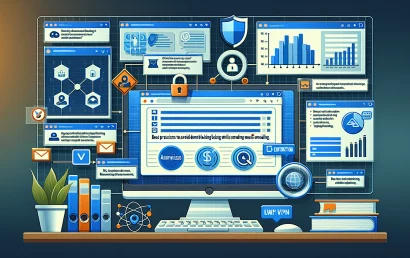How to Avoid Domain Blocking When Sending Emails?

Email marketing can be a powerful tool for businesses looking to connect with their audience, but it comes with its own set of challenges. One of the most significant risks is the potential for domain blocking. When a domain gets blocked, it can severely impact your email deliverability and your overall marketing efforts. Therefore, understanding how to avoid domain blocking is crucial for anyone involved in email campaigns.
In this article, we will explore effective strategies to ensure your domain remains in good standing while maximizing your email outreach. By following these guidelines, you can significantly reduce the chances of your domain being flagged or blocked, allowing you to maintain a healthy email reputation.
Understanding Domain Reputation
Your domain's reputation is a critical factor in email deliverability. Internet Service Providers (ISPs) and email clients use various metrics to assess the trustworthiness of a domain. A poor reputation can lead to your emails being marked as spam or, worse, your domain being blocked altogether.
Factors Affecting Domain Reputation
Several elements contribute to your domain's reputation, including:
- Sending History: A consistent sending pattern helps build trust with ISPs.
- Engagement Rates: High open and click rates indicate that your emails are valued by recipients.
- Spam Complaints: A high number of complaints can quickly tarnish your reputation.
- Blacklist Status: Being listed on email blacklists can have severe consequences for your domain.
«Your domain's reputation is not just a number; it's a reflection of how your audience perceives your brand.» — Email Marketing Expert
Best Practices to Avoid Domain Blocking
To maintain a positive domain reputation and avoid blocking, consider implementing the following best practices:
Warm Up Your Domain
Before launching a large email campaign, it’s essential to gradually increase your sending volume. This process, known as «warming up» your domain, helps establish credibility with ISPs. Start by sending a small number of emails to engaged recipients and gradually scale up as your reputation improves.
Maintain a Clean Email List
Regularly cleaning your email list is vital. Remove inactive subscribers and ensure that you only send emails to those who have opted in. This not only improves engagement rates but also reduces the likelihood of spam complaints.
Monitor Engagement Metrics
Keep a close eye on your email engagement metrics, such as open rates, click-through rates, and unsubscribe rates. High engagement signals to ISPs that your emails are relevant and wanted, while low engagement can raise red flags.
Use Authentication Protocols
Implementing authentication protocols like SPF, DKIM, and DMARC can help protect your domain from spoofing and phishing attacks. These protocols also enhance your credibility with ISPs, making it less likely for your emails to be flagged.
Avoid Spammy Practices
Refrain from using deceptive subject lines, excessive exclamation points, or misleading content. These practices can lead to spam complaints and damage your domain's reputation. Always prioritize transparency and honesty in your messaging.
Main advantages and disadvantages
Advantages of Avoiding Domain Blocking
Maintaining a good domain reputation and avoiding blocking comes with several benefits:
- Improved Email Deliverability: A positive domain reputation ensures that your emails reach the inbox instead of the spam folder.
- Higher Engagement Rates: When your emails are delivered successfully, you are more likely to see higher open and click-through rates.
- Brand Credibility: A well-maintained domain enhances your brand's credibility and fosters trust among your audience.
- Cost-Effective Marketing: Avoiding domain blocking reduces the need for constant list rebuilding and rebranding efforts, saving you time and money.
Disadvantages of Domain Blocking
On the other hand, the consequences of domain blocking can be severe:
- Loss of Communication: If your domain is blocked, your emails will not reach your audience, leading to missed opportunities.
- Reputation Damage: A blocked domain can harm your brand's reputation, making it difficult to regain trust with your audience.
- Increased Costs: You may incur additional costs to resolve the issue, such as hiring experts to improve your email practices or investing in a new domain.
- Time-Consuming Recovery: Restoring a blocked domain's reputation can be a lengthy process, requiring consistent effort and monitoring.
Thematic table
| Strategy | Description | Benefits | Potential Challenges |
|---|---|---|---|
| Warm Up Your Domain | Gradually increase your sending volume to build credibility with ISPs. |
|
|
| Maintain a Clean Email List | Regularly remove inactive subscribers and ensure opt-in compliance. |
|
|
| Monitor Engagement Metrics | Track open rates, click-through rates, and unsubscribe rates. |
|
|
| Use Authentication Protocols | Implement SPF, DKIM, and DMARC to protect your domain. |
|
|
| Avoid Spammy Practices | Use honest subject lines and avoid misleading content. |
|
|
Let's summarize the category:
Successfully avoiding domain blocking is essential for maintaining a robust email marketing strategy. By implementing best practices such as warming up your domain, maintaining a clean email list, monitoring engagement metrics, using authentication protocols, and avoiding spammy practices, you can significantly enhance your domain's reputation.
Each of these strategies plays a crucial role in ensuring that your emails reach their intended recipients and that your brand maintains credibility in the eyes of both ISPs and your audience.
«The key to successful email marketing lies not just in the quality of your content, but also in the integrity of your domain.» — Email Marketing Specialist
By focusing on these aspects, you can create a sustainable email marketing environment that fosters trust, engagement, and ultimately, business growth. Remember that the health of your domain is a continuous effort that requires regular attention and adaptation to changing best practices and technologies.





